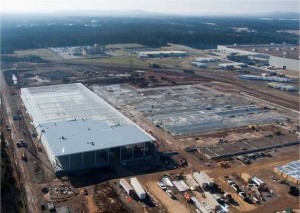
Nissan's big plant in Smyrna, TN is undergoing extensive rennovations to permit it to produce the new Leaf there, likely starting in late 2012.
U.S. production of the Nissan Leaf is now likely to begin on time, in late 2012, a senior official told TheDetroitBureau.com, in spite of earlier fears the project would be delayed in the wake of the devastating earthquake and tsunami that struck Japan on March 11.
The upbeat pronouncement came just a few weeks after another Nissan official warned that the project could very well be delayed by the disaster. There are still some challenges to overcome, however, cautioned Bill Krueger, Nissan’s director of procurement and supply chain management, notably including delays in the rigorous training program for the American workers who are expected to produce the complex battery-electric vehicle at the maker’s assembly plant in Smyrna, Tennessee.
“We’re still targeting to launch Nissan Leaf production and the production of the batteries that will power them at Smyrna late next year,” said Krueger.
Nissan launched production of the Leaf in Japan, late in 2010, and initially maintained an extremely slow pace on the assembly line to help ensure quality. Even then, the maker discovered an unexpected problem with a small number of early battery cars that required modest tweaks to its controller software.
Production is now in the ramp-up phase in Japan and is on track to grow sharply through to late 2012 when Leaf also begins rolling out of Smyrna. American sales have increased almost tenfold since the beginning of this year and are now running in excess of 4,000 a month.
But the goal is to reach significantly higher volumes still, the U.S. factory tooled to produce as many as 150,000 of the battery-electric vehicles, or BEVs, annually.
(Nissan and its French alliance partner Renault will also launch battery car production in Europe, giving them global capacity in excess of 500,000 vehicles annually, a number that will include not just the Leaf but a planned Infiniti model and several Renault BEVs, as well.)
The quake, which appears to have killed well in excess of 20,000 – and still leaves the Japanese auto industry struggling through shortages — threatened to throw the best-laid plans of the alliance partners into turmoil.
Hideaki Watanabe, Nissan’s Vice President of Zero Emission Vehicles, expressed serious concern about the schedule for the U.S. portion of that roll-out, last month, warning the March disaster “put us in a very difficult situation.” (Click Here for that initial report.)
It immediately delayed Leaf production in Japan due to serious damage at various Nissan suppliers. But the intense training program for Smyrna’s assembly line team leaders also was put on hold for a month, a longer-term threat to the U.S. roll-out.
Company insiders say that efforts are underway to make up that lost time, Krueger confirming, “We are putting countermeasures in place to try to accelerate our schedule. We have just shy of a year-and-a-half to make it up.”
To keep the U.S. Leaf project on schedule, Nissan also has to ensure it can stay on task with the production of the electric vehicle’s battery packs. A new facility at Smyrna will be able to produce as many as 200,000 of those lithium-ion packs annually.
Some quick math reveals the capacity to produce about 50,000 extra battery packs. A small number of those will be used to provide load-leveling capacity to the various solar-powered charging stations that will be installed at Nissan operations in Tennessee, noted David Reuter, the maker’s vice president of communications.
As for the rest, Nissan isn’t saying. But sources hint it is possible those could be used for another battery electric vehicle, perhaps the Infiniti model that Nissan’s luxury brand has confirmed it is working on. The maker has yet to provide details about that more luxurious sibling to the Leaf, including whether it could be produced in the U.S.
